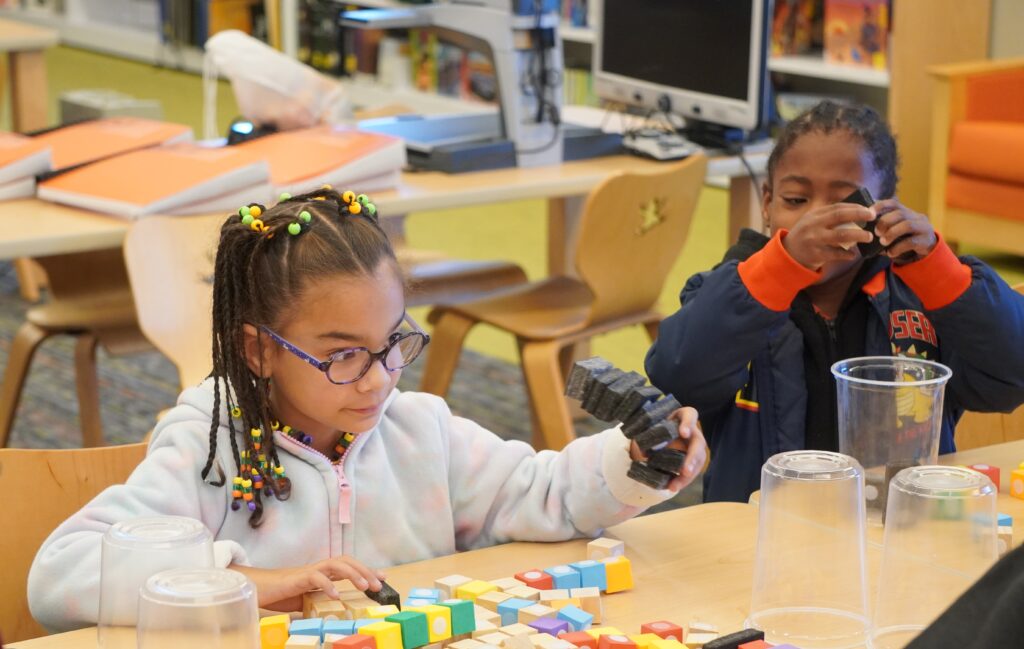Students at the Maryland School for the Blind engaged in a hands-on STEM activity enriched by the resources provided by the nonprofit organization Learning Undefeated. On a recent Friday, participants, including students Ava Williams and Terrell Brown Jr., worked with foam cubes and acoustic foam, using their tactile senses to create various projects while learning about science, technology, engineering, and mathematics. The nonprofit’s mission is to increase accessibility to STEM education for underserved youth, a goal that sparked excitement among the students as they built miniature chairs and artificial pollinators inspired by stories like “Goldilocks and the Three Bears” and “Jack and the Beanstalk.”
Learning Undefeated has been active for over two decades, but this recent visit represented a milestone, as it was the first time the organization brought its Mobile eXploration Lab to the Maryland School for the Blind. This innovative lab is a 1,000-square-foot mobile classroom, designed to engage students through practical learning experiences. The visit was made possible by funding from the Weinberg Foundation, which supports educational initiatives in low-resourced areas. This is part of a larger initiative that included visits to nine other schools in Baltimore, emphasizing the foundation’s commitment to equity in education.
Janeé Pelletier, the chief marketing officer of Learning Undefeated, shared the organization’s vision of promoting diversity in STEM fields. A crucial aspect of their programming revolves around instilling in students the understanding that their perspectives are valuable in the world of science and technology. To ensure that the programming is inclusive, especially for students who are blind, visually impaired, or have low vision, Learning Undefeated employed materials such as Velcro, foam cubes, and colorful pompoms, with some activities specifically crafted for wheelchair users. The curriculum design incorporated storytelling in Braille, making the projects accessible and engaging for all learners, regardless of their physical abilities.
On the last day of programming at the Maryland School for the Blind, instructors combined literature with hands-on activities, leading students through creative construction projects. Following story readings, educators prompted discussions, allowing students to connect the narrative elements with real-world applications. For example, they had students build a chair for Goldilocks or design an artificial pollinator. This not only fostered creativity but also embedded critical thinking and problem-solving skills into the learning experience, aligning with the core objectives of STEM education.
As students like Ava and Terrell tackled their tasks, the atmosphere was one of enthusiasm. Under the guidance of Emily Muhler, an education outreach coordinator, they expressed their engineering ambitions with pride. This educational approach helped reinforce the concept that success in STEM requires both collaboration and innovative thinking, which are essential for future engineers. Participants used various materials, creatively repurposing cups and other items from the activity kits, demonstrating resourcefulness and encouraging a sense of ownership over their projects.
In another example of teamwork, students Lucienne Penny and Kindle Greene worked together on a project that involved simulated pollen collection using construction paper butterflies and pompoms. This exercise not only reinforced the environmental themes inherent in their narrative but also emphasized measurement and analytical skills. As the students engaged with the materials, they learned valuable lessons about patience, adaptability, and the joy of discovery in the learning process. Regardless of the outcomes of their individual projects, the experience created lasting memories and a deeper appreciation for STEM education, which will resonate with these young learners as they move forward in their academic journeys.

